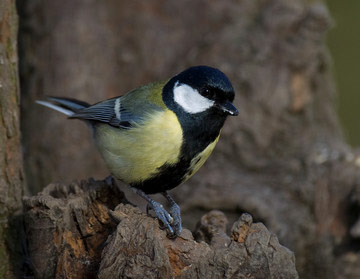
Great Tit © Sue & Andy Tranter
In autumn, Great Tits gradually shift in diet from invertebrates to seeds and fruit, so that by November, seeds such as beechmast and hazelnuts provide a major part of their daily intake. Many males remain on their territories year-round provided that they can find enough food, but most birds move into winter flocks that roam around a few hectares of feeding area. These two facts drive the species’ winter distribution and habitat use.
The winter map shows that Great Tits explore almost every part of the county, including the tetrads on the fringes – the highest hills and Hilbre – that do not support breeding birds. The habitat codes demonstrate slight reductions in the fraction of records in woodland and human sites, larger decreases in the proportions in scrub (8% in breeding season, 5% in winter) and farmland (12% in breeding season, 7% in winter) while the percentage of records in hedges more than doubled from 12% to 26%. These probably illustrate the species’ two main winter feeding areas, woodland and gardens, using hedgerows to move around.
Flocks form above all in hard weather, of which there was little during this winter Atlas, so most birds were found in small groups, with a median count of just three. The large numbers are mainly at well-stocked feeding stations close to woodland and, especially, in areas with lots of tree seeds. Great Tits are much more ground-feeders than their close relatives, and can gather into large flocks, especially when feeding on beechmast. I well remember trying to catch Bramblings feeding on the ground under beeches at Petty Pool (SJ66I) on 19 December 1992, but instead finding my mist-nets full with 98 Great Tits. They extract the kernel of beech nuts by making a characteristic neat hole in the side, and the woodland floor can be littered with such evidence. As supplies of nuts become exhausted during the winter, Great Tits move out of the beechwoods in the order of their social dominance: first to go are first-year females, then adult females, followed by first-year males and finally adult males (Gosler 1993).
As well as woodland seeds, the provision of food by humans is thought to be particularly important for Great Tits, which seem to be among the most intelligent of birds and can quickly learn to exploit new opportunities. An extreme effect of garden feeding was found in northern Finland, turning a migratory population into a sedentary one (Migration Atlas). Despite the dangers of feeding in British gardens, especially cats, Great Tits’ winter survival is higher in suburban areas than in woodland; but the best places to breed are in the woods, and birds have some tricky choices to make in deciding between, or moving between, the two (Gosler 1993).
Great Tits are generally sedentary birds, most males settling to breed within a few hundred metres of their natal site and most females within 1 km, but half of first-year birds move more than 4 km away during winter, tending to return as spring approaches (Migration Atlas). Some birds are already paired within the winter flocks, anticipating the breeding season.
Sponsored by Paul S. Lewis

